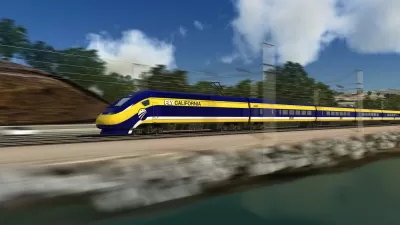All Aboard Florida, the diesel-powered, high speed (125 mph) train connecting Miami to Orlando has ordered new locomotives and coaches with Siemen's Sacramento, California plant. The mostly privately funded train should be running by 2016.
"The trains will be built for maximum speed of 125 mph and will be assembled at Siemens’ solar-powered rail manufacturing hub in Sacramento," writes Paul Brinkmann for the Orlando Sentinel. The announcement was made on Sept. 11.
Don Robinson, All Aboard Florida president and CEO, said the company chose Siemens believing that it will “set a new industry standard, while providing the world-class amenities our customers will expect from our passenger service.
Siemens’ Sacramento plant, which has been in operation for almost 30 years, is up to 80 percent powered by two megawatts of solar energy and employs more than 800 people.
The train system will be built in two phases: Miami to West Palm Beach by 2016, and then extended to Orlando International Airport a year later. Five sets of trains will serve the initial route, "consisting of two diesel-electric locomotives, one on each end of four passenger coaches," writes Brinkman.
Expansion to seven coaches per train is anticipated eventually, and All Aboard expects to purchase an additional five sets of trains for the segment from West Palm Beach to Orlando International Airport.
The station platforms will allow for level boarding to greatly increase accommodation of those in wheelchairs, and those using bikes and strollers. And yes, the trains will have wi-fi.
According to the train's press release, "All Aboard Florida will be the first privately owned, operated and maintained passenger rail system in the United States," but Curtis Tate of McClatchy Washington Bureau notes "it did apply for a $1.6 billion loan from the Federal Railroad Administration. If the agency approves the loan, it would be the largest awarded under the Railroad Rehabilitation and Improvement Financing program."
FULL STORY: Siemens to build All Aboard Florida trains

Alabama: Trump Terminates Settlements for Black Communities Harmed By Raw Sewage
Trump deemed the landmark civil rights agreement “illegal DEI and environmental justice policy.”

Study: Maui’s Plan to Convert Vacation Rentals to Long-Term Housing Could Cause Nearly $1 Billion Economic Loss
The plan would reduce visitor accommodation by 25% resulting in 1,900 jobs lost.

Why Should We Subsidize Public Transportation?
Many public transit agencies face financial stress due to rising costs, declining fare revenue, and declining subsidies. Transit advocates must provide a strong business case for increasing public transit funding.

Paris Bike Boom Leads to Steep Drop in Air Pollution
The French city’s air quality has improved dramatically in the past 20 years, coinciding with a growth in cycling.

Why Housing Costs More to Build in California Than in Texas
Hard costs like labor and materials combined with ‘soft’ costs such as permitting make building in the San Francisco Bay Area almost three times as costly as in Texas cities.

San Diego County Sees a Rise in Urban Coyotes
San Diego County experiences a rise in urban coyotes, as sightings become prevalent throughout its urban neighbourhoods and surrounding areas.
Urban Design for Planners 1: Software Tools
This six-course series explores essential urban design concepts using open source software and equips planners with the tools they need to participate fully in the urban design process.
Planning for Universal Design
Learn the tools for implementing Universal Design in planning regulations.
Smith Gee Studio
Alamo Area Metropolitan Planning Organization
City of Santa Clarita
Institute for Housing and Urban Development Studies (IHS)
City of Grandview
Harvard GSD Executive Education
Toledo-Lucas County Plan Commissions
Salt Lake City
NYU Wagner Graduate School of Public Service



























